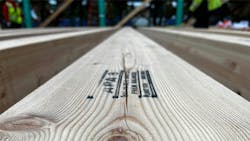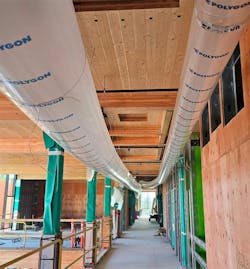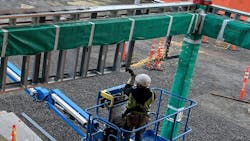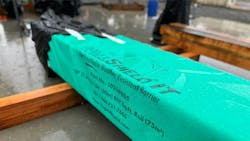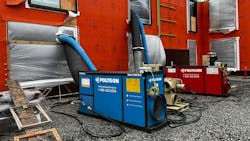5 lessons in water mitigation for mass timber projects
Mass timber has gained popularity as a building material praised for its sustainability and aesthetic appeal. It offers significant environmental benefits because of its reduced carbon footprint, and its biophilic design elements which bring a natural, warm aesthetic that can support cognitive performance, physical health, and psychological well-being.
Yet, its rising popularity poses questions about mass timber’s durability and its response to events during construction such as rain, storms, and humidity. Also in question is its long-term performance in roofs, balconies, and other areas in a building with prolonged exposure to moisture. To effectively design and build mass timber structures that are resilient against water-related damage, builders must plan for effective moisture mitigation throughout the lifecycle of the project, both during installation and in-service.
Skanska, a global leader in sustainable building, along with industry leaders at RDH and Polygon, have amassed valuable insights through extensive experience in building mass timber projects across the country. Here are five tips for successful water mitigation in mass timber construction.
1. Begin with collaborative planning and design consultation
Effective water mitigation starts with collaborative planning and design. It’s essential to consider project scope, product and design specifications, the extent of timber exposure, and environmental conditions. Early-stage involvement from knowledgeable general contractors and mass timber installers enables better planning for a detailed assessment of potential risks and the development of tailored solutions to alleviate risks.
Understanding client goals and budget constraints is a fundamental part of the planning process and risk reduction. Water mitigation strategies can require additional costs, so it’s vital to communicate the various levels of protection available, from high-end solutions to more cost-effective options. There is also the balance of passive protection techniques with sealers, finishes, temporary membranes versus active measures such as labor on site to squeegee, broom, or leaf blow moisture off the timber. Not having the protection planning conversations up front can delay the project and increase the cost of timber repair, cleaning, and finishing.
During construction of the Washington Center for Deaf and Hard of Hearing Youth (CDHY) in the Pacific Northwest, the schedule put mass timber erection into the winter months. The team was faced with almost an inch and a half of rain per week, short daytime periods, and minimal sunny days which inhibit drying.
To mitigate the rain’s impact, the team developed multiple contingency plans to address different weather scenarios including clear dry days, moderate to heavy rain, or flooding. Plans included everything from using a liquid-applied waterproof flashing that ensures there is no water passing between panel joints on heavy rain days, to installing a temporary roof over portions of the structure to keep roofing activity progressing forward.
Effective planning also requires coordination with mass timber suppliers to determine the moisture protection measures that will be implemented by the supplier, versus those that will be added in the field. Once the construction team receives the material, they can implement their pre-coordinated construction sequence such as timber erection, temporary protection at timber joints, exterior enclosure, floor topping, building acclimation, and building finishes with MEPF fit-out.
2. Prioritize product selection and application
Selecting the appropriate water mitigation products and applying them correctly is crucial for effective water mitigation. Different types of mass timber, such as Cross-Laminated Timber (CLT), Nail-Laminated Timber (NLT), Dowel-Laminated Timber (DLT), and Mass Plywood Panels (MPP) have varying susceptibilities to moisture. For example, CLT and MPP are moderately more dimensionally stable with surface bound water on top of the panel, whereas NLT and DLT require additional protective measures. Understanding these differences allows builders to tailor their approach for the specific type of timber used across each project.
During construction of the Class of 1986 Fitness and Wellness Center at Princeton University in New Jersey, Skanska used pre-applied peel-and-stick membrane from VaproShield on the NLT panels to prevent water ingress. The pre-applied membrane provided a protective barrier, ensuring the panels remained dry during transportation and installation. Additionally, they incorporated gaps between NLT panels to account for their natural expansion resulting from humidity and other environmental conditions.
The importance of product selection and application extends beyond the initial planning phase. You must also factor how to minimize risk to the timber during the construction process and beyond. For instance, Skanska often uses water repellant sealers that prevent water from penetrating the timber fibers. The application of sealers is particularly useful on glulam framing members and provide an additional layer of protection during construction. The sealers reduce the work required to remove staining on framing members.
3. Adapt to project-specific conditions
Adapting to project-specific conditions and components is a critical part of field execution for a mass timber project, and an essential factor of successful water mitigation. Floor plate size, roof structure, amount of exposed timber, finished material, as well as climate, sequence of installation and construction timeline, significantly influence the mitigation strategy. Being able to adapt to these conditions cannot be understated.
Each mass timber project will holistically have a different set of needs. For example, when Skanska was constructing the Shiley Marcos Center for Design and Innovation in Portland, Oregon, the project featured smaller floor plates that could be covered with temporary tarps and dried incrementally. This approach was effective for managing moisture on a smaller scale, allowing the team to move quickly and cover a few hundred to a couple thousand square feet per day.
However, larger projects with more extensive floor plates require more comprehensive tactics, such as pre-applying protective membranes to avoid moisture issues during the lengthy installation phase. Working with design consultants, such as RDH, to understand where permeable versus impermeable membranes should be utilized is critical.
Contractors, suppliers and subcontractors should discuss how certain peel and stick products perform under construction conditions with heavy foot and equipment traffic. Larger floor plates may also require additional labor to remove pooling or ponding water from exposed timber surfaces. By having active and passive methods or protection, the project teams can be flexible to various project, site and climate conditions.
4. Implement multi-level quality assurance and control
Multi-level quality assurance (QA) and quality control (QC) processes are vital to ensuring the effectiveness of water mitigation strategies. This includes third-party inspections, real-time monitoring using advanced sensors, regular site audits, and ongoing evaluations to ensure that the mitigation strategies remain effective throughout the construction process and beyond.
One example of Skanska's commitment to QA is its collaboration with RDH and Polygon. RDH provides third-party moisture content surveys to verify that the timber meets the specified moisture levels before and after installation. RDH also assists with drying interventions, assessment of drying rates of wetted wood, and the impact of different temporary membranes with various product properties and applications. This additional layer of assurance ensures that the water mitigation strategies are effectively implemented.
Similarly, Polygon’s sensors play a crucial role in real-time monitoring. These sensors are installed in the timber to continuously measure moisture content, temperature and relative humidity. For instance, in the Redmond Technology Client and CDHY projects Skanska completed, these sensors provided real-time alerts and live dashboards with historic measurements, allowing the team to promptly address any moisture-related issues.
This was essential for making immediate adjustments to the water mitigation strategy or climate control equipment (dehumidification, temporary heat and ventilation), ensuring the timber remained within the acceptable moisture range. In fact, technological advancements have since been made where sensor data can be used to automatically control equipment managing spec conditions with less energy.
5. Continue pursuit of resilient long-term timber buildings
Water exposure during the lifespan of a building is not new to construction and the insurance industry. However, extra planning, coordination, and attention is required when considering strategies to detect, moderate, and control potential water issues after the building is complete and throughout its lifespan.
Areas like balconies and bathrooms may need additional measures to help control moisture with direct applied barriers on top and on the edges of the mass timber panels. Additionally long-term moisture sensors can be installed in these areas to notify building owners of potential moisture development in unwanted locations.
Polygon for example, is focused on reducing builders’ risk in two key areas to advance mass timber use. They are advancing their water damage prevention capability to include leak detection, flow monitoring and control extending safeguards well into occupancy. Their team is also testing new techniques to effectively dry out mass timber materials in the event of significant water damage.
Looking forward
Understanding water mitigation for mass timber is essential to advancing the sustainable building industry. Effective water mitigation is not just about choosing the right materials and techniques, it’s about comprehensive planning, adapting to specific conditions, quality assurance, and ongoing education of stakeholders.
